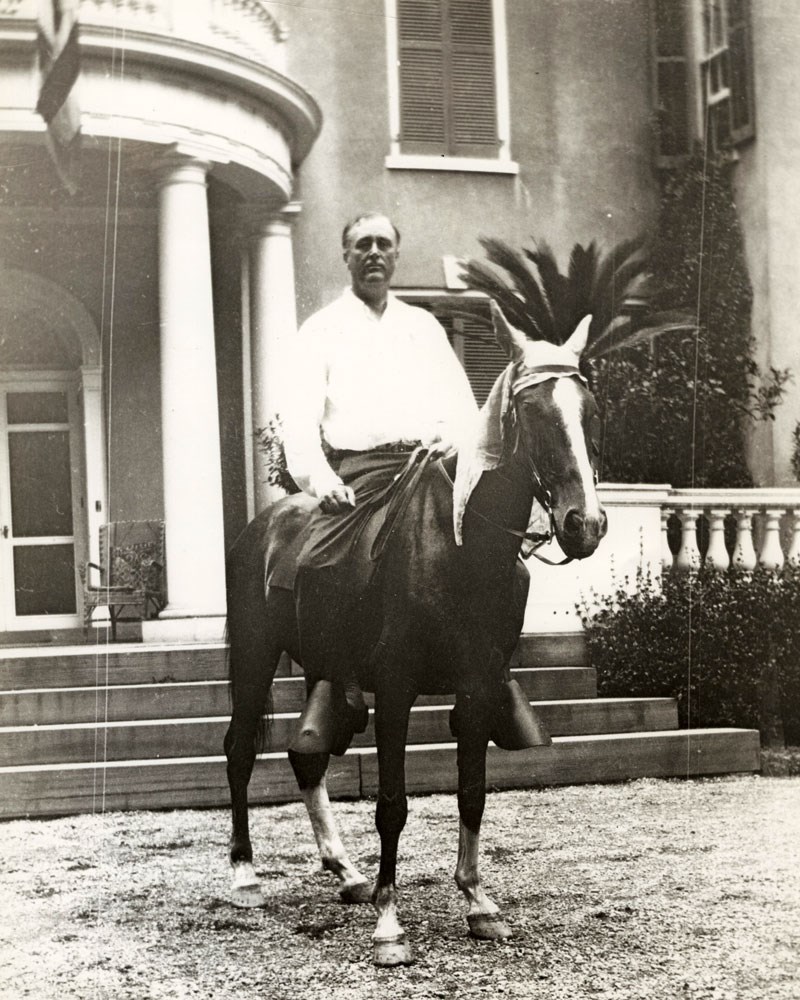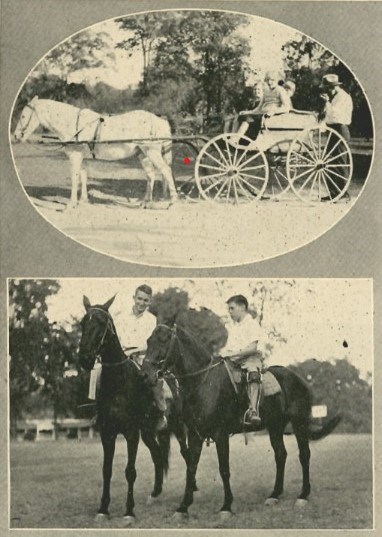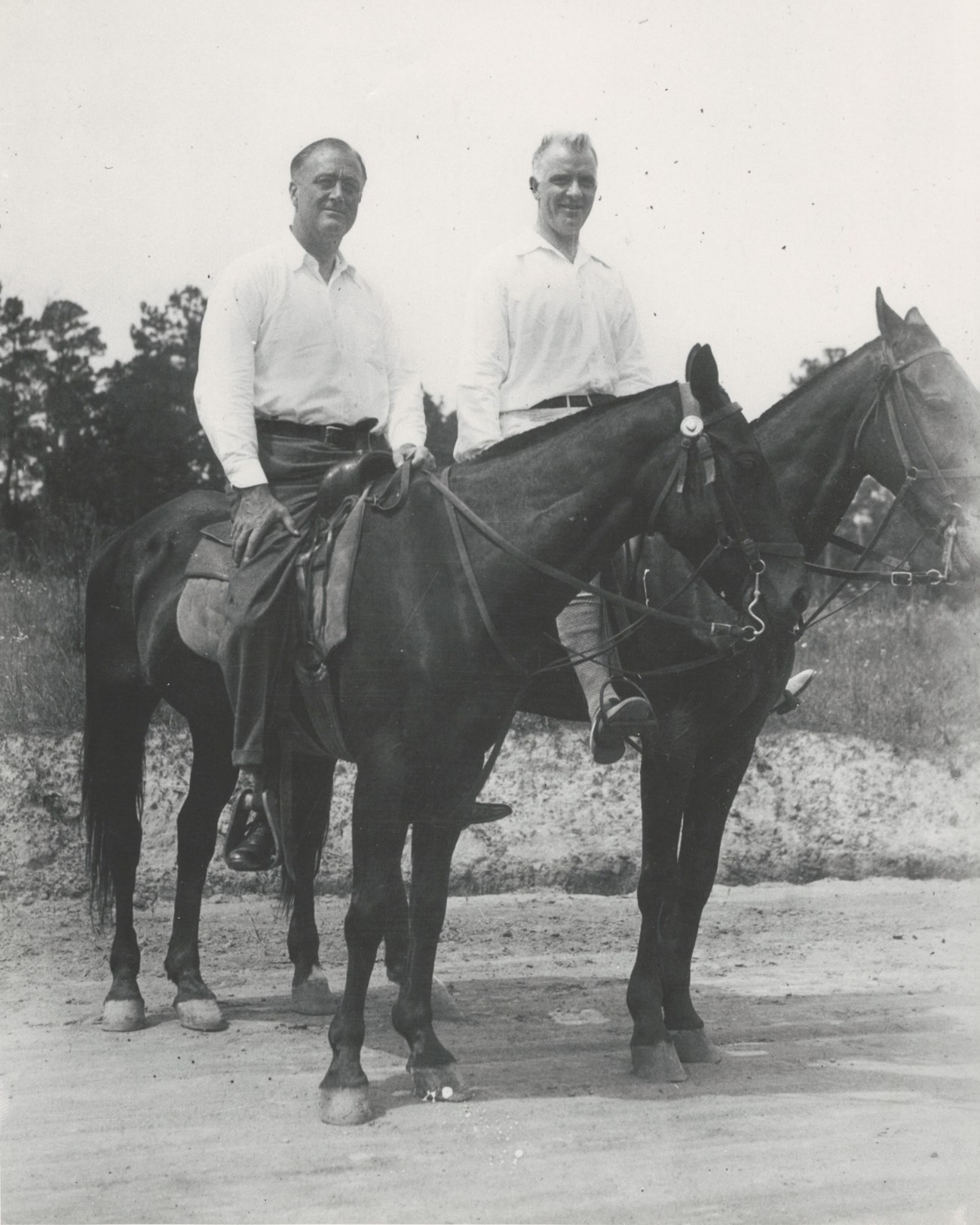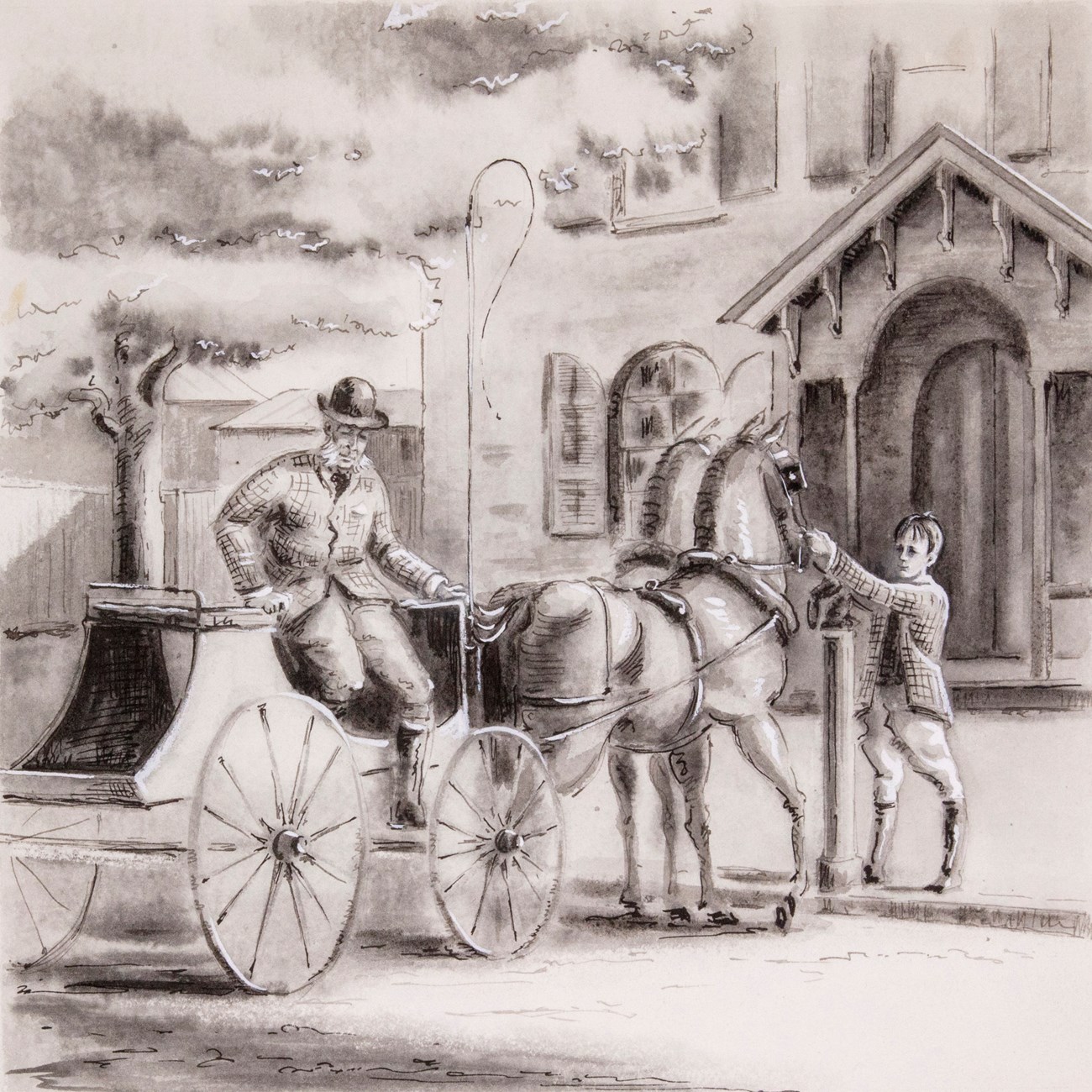Last updated: May 29, 2025
Article
FDR, Horses, & Health

FDR Library Photo
Horses were both an essential means of transportation and farmwork—used to pull firewood, carry crops to the cellars, harvest ice from the pond, as well as for trips to town, church, or social calls—but to the Roosevelts and Delanos they were much more. FDR’s father, James Roosevelt, was a notable horseman and breeder of Standardbred trotters used in harness racing as well as draft horses suitable for farm work. His mother, Sara Delano Roosevelt, grew up with “as many as a dozen horses” at any given time in the ornate stables behind their house at Algonac (Kleeman, 1935, p. 24). FDR’s half-brother, James Roosevelt Roosevelt or “Rosy” as he was called, also took great interest in acquiring, breeding, training, and showing elite, “blooded” horses. In particular, Rosy was well-known among aristocratic circles for enjoying the nostalgic hobby of coaching, that is, driving English stagecoaches at breakneck speeds through the upstate New York countryside. Sara Delano’s brother, Warren Delano IV, bred and maintained 65+ horses at Steen Valetje, his residence, just fifteen miles from FDR’s home in Hyde Park. FDR was a frequent visitor to Warren’s estate for family horse rides. FDR’s daughter Anna said her fondest memories of growing up in Hyde Park revolved around horses, including riding on the front of her father’s saddle just as James had done with both Rosy and FDR (Columbia Oral History Project). Eleanor Roosevelt, once said, “Our children were never without horses and dogs as their pets when they were at home” (Roosevelt, 1949, p. 14). On his father’s side, FDR fondly remembered how his grandfather Jacobus, also called James, rode horses until the last year of his life, aged 87 (Ward, 1985, p. 248). His descendants, especially FDR’s father, would do the same.
A History of Horses and Health
Horseback riding and other equestrian activities were used as medical treatments and forms of therapy for many members of the Roosevelt and Delano families. For example, James suffered from ill cardiac health in the last years of his life. He sought a variety of treatments and therapies, but as a devoted equestrian he made sure to continue to ride horses. He even managed a daily ride up until only a few weeks before his death, despite using a wheelchair at times (Ward, 1985). His family saw how much he enjoyed being outdoors on horseback. Shortly before James died from heart failure, Sara and Franklin gave him a young, Standardbred horse named Bobby. They described Bobby as “a beauty, only five years old and kind and gentle . . . Kentucky-bred" (quoted in Ward, 1985 p. 211). Eleanor thought Bobby “a very good horse, but gentle because his father had heart trouble, and his father rode it only a short time, then it became Franklin’s horse” (NPS). In the last months of James’ life, Sara frequently recorded in her diary taking her “beloved patient” for slow rides, walking beside his horse and vigilantly keeping an eye on him. At this point of his declining health, James had to be lifted into his saddle by a groom (Ward, 1985, p. 214). A set of the last photographs ever taken of James show him riding Bobby, just a few months before his death.
Rosy’s wife, Helen Schermerhorn Astor Roosevelt, fell ill while living abroad. James and Sara visited the couple, and Sara became concerned by Helen’s weight loss due to being ill. Sara consulted her family physician for advice. He diagnosed her liver as sluggish and advised that “only a regimen of determined horseback riding could jar it into working properly again” (quoted in Ward, 1985, p. 167). Though Rosy was an accomplished horseman who could have provided Helen with fine horses, it is unlikely she was able to try this treatment as she died soon after at the age of 34.
It is now well known that Theodore Roosevelt struggled with asthma and other illnesses in childhood and continued to do so in his adult life. Both of his sisters also struggled with respiratory issues. TR used horseback riding as one method of exercise to help with these experiences. As early as three years old, TR’s father, Theodore Roosevelt Sr., would take him on fast carriage rides to try and force fresh air into his lungs. Later, TR Sr. would consult with a physician familiar with the first modern treatise on asthma in which horseback riding was included as treatment. TR then incorporated horseback riding as a regime for increasing strength and vitality for the rest of his life. TR famously said, “Of course, there are no pets like horses; and horsemanship is a test of prowess” (Roosevelt, 1905, p. 355). In 1884, during his time as a rancher in the Dakotas, he wrote to his sister Bamie, “I am well hardened now, I have just come in from spending thirteen hours in the saddle’" (quoted in Watts, 2003). Later, TR would even included a 90-100-mile ride over three days as a physical test for admittance to the Navy (Navy General Order No. 6, January 6, 1909).
What is less known, however, is FDR’s relationship to horses post-polio and paralysis.

FDR Library Photo
FDR Riding for Health
There are conflicting accounts on if FDR rode horses for physical rehabilitation, for staged photo opportunities to demonstrate his physical fitness during election years, or for both. It is unlikely he ever rode post-polio purely for pleasure. In This I Remember, Eleanor Roosevelt (1949) recalled,
“Earl Miller, who at that time was a New York State trooper, thought my husband should learn to ride horseback again, as many of the patients at Warm Springs had... My husband was not able to get any pleasure out of riding after he became paralyzed, though he had been a fine horseman. He rode with Earl Miller in Warm Springs and at Hyde Park, but he never got over his sense of insecurity in the saddle, because he could not use the muscles necessary to balance himself on a horse” (p. 28).
According to New York Herald Tribune journalist Ernest K. Lindley, FDR would, however, by 1931 “develop a grip with his knees – although he still keeps the horse at a walk” (Lindley, 1931, p. 35).
Though it is unlikely FDR rode simply for pleasure after becoming paralyzed, there is some evidence FDR rode horses post-polio for health reasons. According to Robert McGaughey, former Roosevelt Houseman and Butler and historical aide at the Home of FDR National Historic Site, FDR did a series of exercises early in his recovery from polio-induced paralysis (circa 1922) “trying to bring back his health” (NPS oral history 1947.08): “Well, he used to do a lot of walking, and he used to go horse riding, horseback riding, and he used to go swimming every day in the afternoon.” According to Mrs. Josephine Plog, wife of the Roosevelt’s gardener, he “tried to ride horseback, but he didn’t do that very long either” (NPS oral history 1947.14). While it is possible FDR’s preferred method of physical rehabilitation was not riding horses, it is apparent he found the activity useful for other people experiencing physical disabilities at his Warm Springs rehabilitation center.
Horseback riding was offered as a form of recreation and possibly physical rehabilitation at FDR’s Warm Springs retreat. In the June 1932 edition of the Polio Chronicle—a newsletter written by The National Patients’ Committee of the Warm Springs foundation—one of the lauded assets of the center was the horses available to residents:
“One of the joys of Warm Springs is the almost human saddle horses, sleek and shining, which may be rented for a nominal sum. For very young people there is a pony cart and a colored man who knows all there is to be known about horses.” (Polio Chronicle, vol. 1, no. 6)

The Polio Chronicle, vol.1, no. 6.
In 1930, The New York Evening Journal reported the following story titled, “Governor Wins Health Fight” with a subtitle of, “Tries Riding Again”:
“This year Roosevelt went back to Warm Springs without any hope for horse-back riding, but his faith in the waters there was so strong he decided to chance riding a horse again. Roosevelt whipped his horse away to a trot. All were aghast, but the Governor came back smiling, enjoying their confusion. On Saturday afternoon, asked by an Evening Journal reporter, how he felt, the Governor said: ‘I feel great! Never better in my life! Eddie Flynn and I have been having a lot of fun swimming, and for the first time in ten years I have really taken to riding horses again. The waters down south are wonderful and they have done me a great deal of good.”
A caption accompanying a photo of himself and “Eddie Flynn” stated:
“Governor Roosevelt, while vacationing in Warm Springs, Ga., rode a horse for the first time in ten years. In this photograph, published exclusively in The Evening Journal, the Governor is seen at the left with Secretary of State Edward J. Flynn, of the Bronx, on their steeds, ready for a canter.”

FDR Library Photo
While not discussed as a medical or therapeutic intervention, the presence of horses at Warm Springs combined with the recorded instances of their use in muscle development by FDR according to him and members of his household, we can safely say horses were being used therapeutically much earlier than the establishment of equine-assisted therapy as a formalized discipline. Interestingly, the establishment of the discipline was inspired by an equestrian paralyzed by polio, just like FDR.
Lis Hartel was a Danish Olympic equestrian born in 1921. In 1944, she was infected with the polio virus and experienced partial paralysis below her knees and in her arms and hands for the rest of her life. She rehabilitated her muscles through many techniques including horseback riding. At the 1952 Olympics Individual Dressage competition—the first year women and people other than non-commissioned military personnel were allowed to compete—Lis Hartel won a silver medal. She won another silver medal in the same sport in 1956. As this was before the invention of ceiling lifts for paralyzed riders, Lis Hartel needed assistance getting on and off the horse—just like FDR and his father did. Her accomplishments as a disabled rider served as the catalyst for the spread of therapeutic riding centers around the world. After Hartel retired from competition, she founded a therapeutic riding center that still serves para-riders today (Hedenborg, 2019).

Gamma-Keystone Photo
FDR Riding for Politics
In FDR’s Body Politics: The Rhetoric of Disability, authors Houck and Kiewe (2003) argued Roosevelt and his advisors developed a visual rhetoric that emphasized the health and fitness of his body. In their book, the authors argued this visual rhetoric took two forms: the appearance of the ability to walk, and the stamina required to extensively travel during campaigns. In this article, I argue Roosevelt used horseback riding as another form of visual rhetoric to emphasize his health and fitness for holding political office.
In the summer and fall of 1932, during Roosevelt’s presidential election campaign, a “whispering campaign” spread against him about his unfitness to service in office. This created a rhetorical bind for Roosevelt in that he needed to counter these claims without making his paralysis the focus, which would likely result in pity from the public. Instead, Roosevelt’s strategy was to show his healthy-yet-impaired body to the public. Most significantly, photos and videos of FDR on horseback served as a previously unexamined form of visual rhetoric for his goal of appearing healthy and fit.

FDR Presidential Library & Museum
Equestrian Influence on Wheelchair Design
In a roundabout way, the innovative design of FDR’s wheelchairs may not exist without horses. While FDR grew up certainly privileged with coachmen and grooms to tend to the family’s horses, he still held responsibilities for their care.
As a young boy of eight, one of these responsibilities was to take the horses to the local blacksmith shop in Hyde Park for shoeing. It was there he met the blacksmith’s teenage son, James Albert “Bert” Wigg, and the two struck up a lifelong friendship. Bert Wigg would grow up to take over his father’s shop—even losing a finger in the process--and would later be appointed Hyde Park’s Postmaster by Franklin. Bert was the third generation Wigg to operate the shop and claim the distinction of shoeing horses for the Roosevelt family. While blacksmiths do not always offer farrier services, shops in small towns like Hyde Park sometimes used their expertise to offer customized shoeing for local horses.
We know little about the process of design for FDR’s customized wheelchairs. According to one source, “Roosevelt’s wheelchair was an old-fashioned, armless kitchen chair with a platform for his feet to rest on and four six-inch wheels that had been attached to the bottom of the chair by the village blacksmith at Hyde Park.” According to the US Census, this likely would have been Bert Wigg. With a lifelong rapport and three generations of family experience, Bert would have been a logical choice for FDR to go to with a design for a customized a wheelchair base.
Whether it be through physical rehabilitation, political efficacy, emotional connection, or innovative wheelchair design, it is clear that horses played a role in the shaping of FDR’s experiences with disability.
—Shelby Landmark, PhD
References
- Halsted, A. R. (1973). Interview by Sargent, J. E. Reminiscences of Anna Roosevelt Halsted. Columbia Oral History Project. Columbia University.
- Hedenborg, S. (2019). Lis Hartel - an extraordinary equestrian. Sport in Society, 20(8), 1030-1046.
- Houck, D. W., & Kiewe, A. (2003). FDR's body politics: The rhetoric of disability. Texas A&M University Press.
- Kleeman, R. H. (1935). Gracious lady: The life of Sara Delano Roosevelt. D. Appleton-Century Company.
- Lindley, E. K. (1931). Franklin D. Roosevelt: A career in progressive democracy. Bobbs-Merill Company.
- Roosevelt, E. (1949). Franklin D. Roosevelt and Hyde Park: Personal recollections of Eleanor Roosevelt. National Park Service.
- Roosevelt, E. (1949). This I remember. Harper & Brothers.
- Roosevelt, T. (1905). Outdoor pastimes of an American hunter. Charles Scribner's Sons.
- Ward, G. C. (1985). Before the trumpet: Young Franklin Roosevelt. Harper & Row.
- Watts, S. (2003). Rough rider in the White House: Theodore Roosevelt and the politics of desire. The University of Chicago Press.
